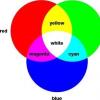Urgently brief retelling on education Slavic states
Answer:
1) The resettlement of the Slavs. --- The Slavs lived next to the Germans. They advanced far to the east and south. Later they divided into three branches: western, eastern, southern. --- Western Slavs are Czechs, Poles, Slovaks. The Slavs also settled part of the Balkan Peninsula = peoples were formed: Bulgarians, Serbs and Croats. --- Eastern Slavs are the ancestors of such peoples as Russian, Ukrainian, Belarusian. 2) Activities and lifestyle of the Slavs. --- The Slavs were engaged in agriculture, cattle breeding and crafts. There was a veche-people's assembly. At the head were military leaders-princes. Horse squads obeyed them, they also raided, took people captive - slaves, livestock, valuables. The Slavs united into allied tribes because of the threat of enemy attacks. 3) Bulgarian state. --- The Slavs who settled north of the Balkan Peninsula were conquered by the Bulgarians. When the ancestors of the Bulgarians migrated to the Middle Volga, as a result, the Bulgarian state was formed there. They dissolved among the Slavs, adopted their language, but gave them their name. --- In the middle of the 9th century, the Bulgarians took Christianity from Byzantium, but were at war with it. --- The ruler in Bulgaria was Simeon (893-927). He managed to win back part of the land, he besieged the capital more than once, sometimes Byzantium was forced to pay tribute to the Bulgarians. As a result of long wars, the country weakened, and after the death of Simeon, Serbia separated from Bulgaria. --- In the 9th century, the Byzantine Emperor Vasily 2 (Bulgarian Slayer) made trips to Bulgaria, destroyed cities, evicted from their native places. The Bulgarian king died because Basil 2 blinded 14 thousand prisoners and sent them home to intimidate. 4) The Great Moravian Power and .... --- In the 9th century, the state of the Great Moravian Power arose near the Morava River. They paid tribute to Germany, adopted Christianity. Then this power entered the struggle with Germany and achieved independence. --- One of the princes concluded an agreement with Byzantium. --- The first enlighteners were the brothers Cyril and Methodius. Cyril: taught philosophy, knew different languages Methodius: ruled one of the Byzantine regions. Soon he headed the monastery --- In 863 Cyril created the alphabet (Slavic writing), Methodius translated several liturgical books. --- In Moravia, they built churches, schools, and trained priests. --- So from Bulgaria the written language passed to Russia. As a result of long wars with Germany, the Great Moravian state weakened. Using this, in 906, the Hungarians captured part of the land. 5) The formation of the Slavic states. ---In the end 9th century formed Old Russian state.After the collapse of the Great Moravian state, the Czech state stood out. In 1085, the Czech prince took the title of king. The Polish prince Meshko1 subjugated the tribes settled along the Vistula River. He also adopted Christianity, strengthened his power. He laid the foundation for the Polish state. ---Unification was completed when Boleslav 1 the Brave ruled. He managed to annex the southern lands. The capital of Poland was in Krakow. And in the middle of the 11th century, Poland entered a period of feudal fragmentation.
Similar questions
Find out who the Slavs are, how their resettlement took place; What did the representatives of the Slavs do, what is their way of life. Get to know the states called Bulgaria, the Great Moravian state. Find out how the Czech state was formed. Today in class:

Since ancient times, the Slavs lived in the Baltics, in Central and Eastern Europe, to the east of the Germans. In the VI century, the Slavs occupied vast areas from the Laba (Elbe) in the west to the middle reaches of the Dnieper in the east, from the Baltic Sea in the north to the Danube and the Black Sea in the south.

Slavic tribes Western Slavs Southern Slavs Eastern Slavs Czechs Czechs Poles Poles Slovaks Slovaks Polabian tribes living east of Laba, Polabian tribes living east of Laba, Pomeranian tribes settled on the eastern coast of the Baltic Sea. Pomeranian tribes settled on the eastern coast of the Baltic Sea. Bulgarians Bulgarians Serbs Serbs Croats Croats and others. and others. the ancestors of three kindred peoples who settled part of the Balkan Peninsula, who settled part of the Balkan Peninsula: the ancestors of three kindred peoples: Russian Russian Ukrainian Ukrainian Belarusian. Belarusian.

The main occupations of the Slavs were - agriculture (wheat, rye), cattle breeding (breeding pigs), crafts. The Slavs were also engaged in beekeeping - collecting honey from wild bees and wax. The Slavs settled along the banks of the rivers, which were the best "roads", and traded. Activities and lifestyle of the Slavs

In the middle of the first millennium of our era, the way of life of the Slavs was similar to that which we know from the history of the ancient Germans. The Slavs were divided into many tribes. All important issues in the tribe were decided by the people's assembly veche (from the word "broadcast" to speak with knowledge of the matter). Activities and lifestyle of the Slavs







Vasily killed about 100 thousand Bulgarians, 14 thousand were blinded and sent home as a deterrent. When the Bulgarian king saw the blind, he died of a broken heart. In 1018, Byzantium completely subjugated Bulgaria. Bulgarian State Blinded Bulgarians.

In the first half of the 9th century, the state of the Western Slavs, the Great Moravian Empire, arose in the valley of the Morava River. At first, it was subordinate to the Franks, and after the collapse of the empire of Charlemagne, Germany. The princes paid tribute to her and accepted Christianity from the German bishops.


To fight Germany, one of the Moravian princes concluded an alliance with Byzantium against her. In order to free the church from the influence of the German clergy, he asked to send missionaries to Moravia to preach Christianity in the native language of the Slavs. Great Moravian State

The first Slavic enlighteners were the Bulgarian monks from Byzantium, brothers Cyril and Methodius. Cyril taught philosophy, knew the languages of different peoples. Methodius, a good organizer, ruled the Byzantine region for about 10 years. Then he became a monk and soon became the head of the monastery. Great Moravian State

In 863, the brothers were sent to the Great Moravian state. Before leaving, Kirill created the Slavic alphabet based on the Greek alphabet. With the help of Methodius, he translated several liturgical books into Slavonic. In Moravia, the brothers built churches, opened a school for the training of priests from local residents. Great Moravian State

After the death of the brothers, the German clergy began to persecute their disciples. Some students found shelter in Bulgaria. Here they continued to translate Greek religious books and contributed to the rise of Bulgarian literature. From Bulgaria, Slavic writing passed to Russia. Great Moravian Power Monument to Cyril and Methodius Odessa

The long struggle with the kings of Germany weakened the Great Moravian state. Taking advantage of this, the Hungarians defeated her in 906 and seized part of her lands. The Great Moravian State collapsed.. The Great Moravian State The only surviving monument of the Great Moravian State


From the collapsed Great Moravian state, the Czech state stood out. In the first half of the 10th century, with the support of the nobility, the princes of the Czech tribe, who lived near the city of Prague, united other tribes under their rule. In 1085, the Czech prince took the title of king, the influence of Bohemia in Europe increased. Formation of Poland and the Czech Republic.

In the second half of the 10th century, the Polish prince Mieszko I () subjugated the tribes that settled along the Vistula River. Together with a 3,000-strong squad, he adopted the Christian faith and thereby greatly strengthened his power. He laid the foundation for the Polish state. Fighting for the unification of the Polish lands, Mieszko made an alliance with the Holy Roman Empire against the Polabian Slavs, but at times supported the German feudal lords against the emperor. Prince Mieszko I Formation of Poland and the Czech Republic

The unification of Poland was completed during the reign of Bolesław I the Brave (). He managed to annex the southern Polish lands. To the city of Krakow large shopping center On the way from Kyiv to Prague, the capital of Poland was moved. Boleslav I managed to capture the Czech Republic with Prague for a while, but soon the Czech Republic was freed from his power Education of Poland and the Czech Republic Boleslav I the Brave

Formation of Poland and the Czech Republic Coronation of Boleslav I the Brave Boleslav went on a campaign to Kyiv, trying to put his son-in-law on the throne, but to no avail. In the west, he fought long wars with the Holy Roman Empire. Shortly before his death, Bolesław was proclaimed King of Poland. In the middle of the 11th century, Poland entered a period of feudal fragmentation.
Materials used in the work: %D0%BB_%D0%B8_%D0%9C%D0%B5%D1%84%D0%BE%D0%B4%D0 %B8%D0%B9 wiki/%D0%9A%D0%B8%D1%80%D0%B8%D0%BB %D0%BB_%D0%B8_%D0%9C%D0%B5%D1%84%D0%BE%D0%B4 %D0 %B8%D0%B9 _Ihttp://ru.wikipedia.org/wiki/%D0%9C%D0%B5%D1%88%D0%BA%D0%BE _I Agibalova E.V., Donskoy G. M. History of the Middle Ages Grade 6 / textbook for secondary schools. - M .: Education, 2008. History of the Middle Ages, grade 6: lesson plans according to the textbook by Agibalova, Donskoy, ed. N.Yu. Kolesnichenko. - Ed. 2, corrected. - Volgograd: Teacher, p.

seizure of the imperial throne of Byzantium. For about 30 years he waged wars with Byzantium, more than once
besieged its capital.
(sl. 11) He managed to win back part of the lands inhabited by the Slavs, to subdue the Serbs.
Simeon called himself "king of the Bulgarians and Greeks."
(sl. 12) But long wars exhausted the country and ruined the population. After death
Simeon Bulgaria weakened, Serbia separated from it. From north to Bulgaria and
Byzantium was raided by the Hungarian cavalry, and then for a century and a half - nomads -
Pechenegs, pushed back to the Northern Black Sea region from the depths of Asia.
Byzantine chronicler about the meeting of the Byzantine basileus Roman I and the Bulgarian
Tsar Simeon
In September (924) ... Simeon with his army moved to Constantinople. He
devastated Thrace and Macedonia, burned everything, destroyed it, cut down trees, and
going up to Blachernae, he asked to send Patriarch Nicholas to him and
some nobles to negotiate peace. The parties exchanged hostages,
and the first to go to Simeon was Patriarch Nikolai (followed by other envoys)...
They are began to talk with Simeon about the world, but he sent them away and
asked for a meeting with the tsar (Roman) himself, since, as he claimed, many
heard about his intelligence, courage and intelligence. The king was overjoyed at this,
longed for peace and wished to stop this daily bloodshed. He sent
people ashore ... to build a reliable marina in the sea, to which
approach the royal trireme. Simeon, meanwhile, sent soldiers and burned the temple
of the Most Holy Theotokos, showing by this that he does not want peace, but fools the king
empty oh hopes. The king, having arrived in Blachernae ... Having supplied his retinue
weapons and shields, he appeared at the appointed place for negotiations with
Simeon ... The king was the first to appear at the mentioned pier and stopped at
waiting for Simeon. The parties exchanged hostages, and the Bulgarians. Thoroughly
searched the pier: is there any trick or ambush, only after that
Simeon jumped off his horse and went in to the king.
(sl. 13 ) At the beginning of the XI century, the Byzantine emperor Vasily II, nicknamed the Bulgar Slayer,
almost annually made trips to Bulgaria. He destroyed cities and villages, evicted
Bulgarians from their native places.
(sl. 14) Having defeated the Bulgarian army, Vasily II ordered to blind 14 thousand prisoners,
leaving one one-eyed guide for every hundred blind, and to intimidate
let them go home. The Bulgarian king at the sight of such a mass of his blinded warriors
died of a heart attack. Using the strife of the Bulgarian nobility in the struggle for power,
Byzantium in 1018 completely subjugated Bulgaria. Bulgaria lost its independence
for over a century and a half.
Great Moravian State.
(sl. 15) In the first half IX century in the valley of the Morava River, a state arose
Western Slavs - Great Moravian State. At first, it obeyed
Franks, and after the collapse of the empire of Charlemagne - Germany. Princes paid eidan
and accepted Christianity from the German bishops
(sl. 16) But then the Great Moravian State achieved independence and entered into
fight against Germany. Several times the German kings invaded and overthrew
1) southern Slavs (Serbs, Croats, Macedonians, Bulgarians and other Slavs of the Balkan Peninsula);
2) Western Slavs (Poles and Czechs);
3) Eastern Slavs (Russians, Belarusians and Ukrainians) - basically they, namely Russians, live in Russia.
Question 2. What was the merit of Cyril and Methodius in the development of Slavic culture?
Answer. Cyril and Methodius baptized Great Moravia. But most importantly, they created the Slavic alphabet, translated the first books into the Slavic language, and also taught the first Slavs to read and write and theology, their students carried knowledge beyond Great Moravia (they were simply expelled from there).
Question 3. Which Slavic state arose before the rest? In what century did the largest number of Slavic states arise?
Answer. The first truly Slavic state was Great Moravia (Avar and Bulgarian states appeared earlier, but these were nomadic states to which the Slavs obeyed). And most of all Slavic states arose in the 9th century (Primorskaya Croatia, Ancient Russia, Great Moravia).
Question 4. Briefly tell about the famous Slavic rulers, first highlighting the Questions that need to be stated.
Answer. In the story, it is necessary to highlight: the place and time of the life of the figure and why his descendants remembered him.
1) Simeon lived in Bulgaria at the end of the 9th and at the beginning of the 10th centuries. He was the greatest ruler of the first Bulgarian state, successfully fought with Byzantium, besieged its capital more than once. Subjugated many Slavic tribes.
2) Mieszko I - the ruler of the Polish state of the tenth century. He converted to Christianity and baptized his people.
3) Boleslaw I the Brave ruled Poland after his father Mieszko I at the end of the 10th and 11th centuries, he united more Polish lands than his father.
Question 5. How is the history of the Slavic states connected with other medieval states known to you?
Answer. Connections:
1) the Bulgarians attacked Byzantium and were eventually subjugated by it for some time;
2) other southern Slavs were under the rule of Byzantium for a long time;
3) the Croats were under the rule of the Franks for a long time;
4) Great Moravia and other Western Slavs were in conflict with the Germans;
5) The Old Russian state had close contacts with Scandinavia, perhaps even was created by the Scandinavians;
6) squads of the Old Russian state went on campaigns against Byzantium;
7) The Old Russian state actively traded with the Arabs.
Question 6. Make a detailed paragraph plan: divide each paragraph into separate parts that are complete in meaning; then briefly formulate the main idea of each part and write it down.
Answer. The main idea of the paragraph is that the paths of different Slavic groups diverged early, their history is diverse. His plan:
1) the resettlement of the Slavs
a) the division of the Slavs into branches
b) Western Slavs
c) South Slavs
d) Eastern Slavs
2) occupations and lifestyle of the Slavs
a) the main occupations of the Slavs in peacetime
b) the control system of the Slavic tribes
c) raids on neighbors
d) the role of prey in the life of the Slavs
3) Bulgarian state
a) the conquest of the Slavs by the Bulgarians
b) the creation of the Bulgarian state
c) Prince Simeon
d) relations with Byzantium
e) destruction of the Bulgarian state
4) Great Moravian state and the creators of Slavic writing
a) the creation of the Great Moravian state
b) the baptism of Great Moravia
c) the activities of Cyril and Methodius
d) features of the Slavic alphabet
e) the fate of the legacy of Cyril and Methodius
5) The formation of Slavic states
a) the formation of the Old Russian state
b) formation of the Czech state
c) formation of the Polish state
d) the final unification of Poland














